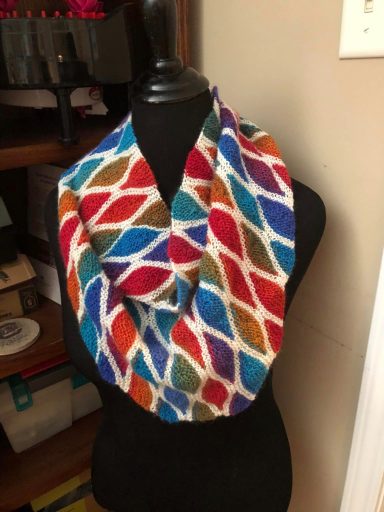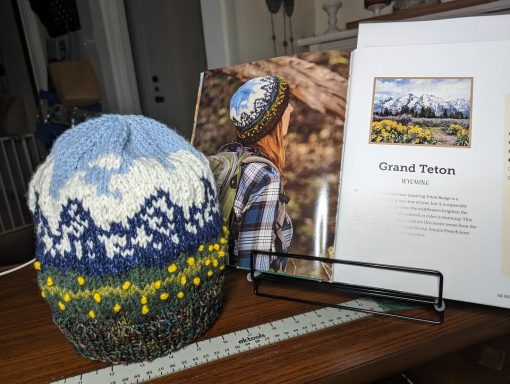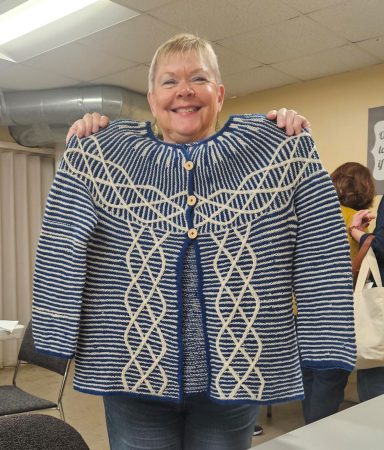Welcome all Knitters
Our monthly guild meetings are held on the last Saturday of each month at the Inman Pubic Library on 50 Mill St., Inman from 10:30am until noonish.
We would love to meet you and cordially invite you to become part of this fantastic group.
At the Spartanburg Knitting Guild, we are passionate about the art and craft of knitting. Whether you're a seasoned expert or just picking up your first set of needles, our guild is a welcoming community where knitters of all skill levels come together to share knowledge, inspire creativity, and foster connections.
Established 1998, our guild has been a vibrant hub for knitters in Spartanburg County and beyond. We believe in the power of knitting to bring joy, relaxation, and a sense of accomplishment to our lives, and we are dedicated to promoting and preserving this timeless tradition.
As a member of the SKG, you'll have access to a wealth of resources and opportunities to enhance your knitting journey. From educational workshops and skill-building sessions to group projects and social gatherings, there's always something happening at our guild to spark your creativity and expand your horizons.
But more than just a place to knit, the SKG is a community—a place where friendships are formed, stories are shared, and laughter is abundant. Whether you're seeking advice on a tricky stitch pattern, looking for inspiration for your next project, or simply craving the company of fellow knitters, you'll find it all here among kindred spirits who share your passion for the craft.
We invite you to join us on this knitting adventure. Whether you're a lifelong knitter or just starting out, this is the place for you. Together, let's knit, create, and inspire!
Melody Motes, President
Greetings Knitters 🧶,
Hard to believe another month has passed already, but here we are. I want to give a big shoutout to everyone who heeded my advice to visit Palmetto Yarn Shoppe on LYS Day. Great turnout and lots of fun.
If you weren’t able to attend, try it soon. They never disappoint 🩷. Lots of beautiful summer knits going around and I hope you find some that are perfect for you.
Knit Away is fast approaching so don’t get left out. Keep knitting and spreading the word about our craft.
Hope to see you at the meeting.
Your humble President 😉,
Melody

History
Short summary of the history of knitting
The history of knitting is rich and fascinating, spanning thousands of years and various cultures around the world. While the exact origins of knitting are uncertain, evidence suggests that it emerged in multiple regions independently.
Early Origins: The earliest known examples of knitting date back to around the 11th century CE in Egypt, where fragments of knitted cotton socks were discovered. However, some scholars argue that knitting may have existed even earlier, possibly in the Middle East or South America.
Medieval Europe: Knitting became more widespread in Europe during the Middle Ages, particularly in countries like Spain, France, and England. Initially, it was primarily practiced by men, often as a trade guild skill. The first knitting guilds appeared in Europe in the 13th century.
Renaissance: Knitting gained popularity among European aristocrats during the Renaissance. It was considered a valuable skill, and finely crafted knitted garments became status symbols.
Industrial Revolution: The invention of knitting machines during the Industrial Revolution in the 18th century revolutionized the production of knitted goods, making them more accessible to the general population. However, hand knitting continued to be practiced in homes, especially for intricate designs and personalized items.
19th and 20th Centuries: Knitting remained popular throughout the 19th and 20th centuries, with trends and techniques evolving alongside changes in fashion and technology. World War I and World War II further popularized knitting as women on the home front knitted socks, scarves, and other items for soldiers.
Revival and Modern Era: In the late 20th and early 21st centuries, knitting experienced a revival as a hobby and art form. Knitting communities formed both online and offline, sharing patterns, techniques, and inspiration. Knitting has become not only a practical skill but also a form of creative expression for many people.
Throughout its history, knitting has served various purposes, from providing clothing and warmth to expressing cultural identity and creativity. Today, it continues to evolve as new materials, technologies, and design trends emerge, ensuring its enduring popularity across the globe.
Gallery
"Welcome to our knitting guild, where needles click and creativity flows! Our members are a tapestry of talent, each bringing their unique skills and styles to the table. From intricate lacework to cozy cables, colorful Fair Isle to whimsical amigurumi, there's no limit to the magic our members can create with just a ball of yarn and a pair of needles. Whether you're a seasoned pro or a budding beginner, you'll find inspiration, support, and plenty of opportunities to showcase your talents among our knit-tastic community!"
Membership
Dues are due now ! Please pay them before the end of March. Annual dues are $15.00. We have three ways for you to pay, to ake it easy.
1. Via US snail mail to the treasurer (check only, please. NOTE: Make checks out to Spartanburg Knitting Guild.)
2. Via cash or check at the Palmetto Yarn Shoppe. You may also pay them at the monthly meetings.
3. Via PayPal using bank account or charge card (fees apply)
Newsletter
Greetings to All,
Hope this finds everyone doing well. We sure have been on a ride since our last meeting (weather and lots of sickness). I thank Vicky for our informative GSR demonstration. Even with all the technical difficulties, she mustered through. 👏🏼
I sincerely ask each and everyone of you, if you have a skill/technique that you would be willing to share, please reach out to Vicky or myself. You know you know 😉.
Stay well and I hope to see you at our next meeting 🧶
Sit & Knit Groups
The Sit and Knit group will be meeting the second Saturday of the month @10:00am at
Spill the Beans
174 E. Main Street, Spartanburg SC
Come enjoy a cup of coffee and fellowship with fellow knitters!
The Knit Knuts meet every week Thursday through Sunday at
Palmetto Yarn Shoppe 221 N Main St. Campobello, SC
during business hours.
Knitting vs Crocheting
What's the difference?
Knitting and crocheting are both crafts that involve creating fabric from yarn using special tools, but they differ in several key ways:
Tools: Knitting uses two long needles, typically straight or circular, with points at one end. Crocheting, on the other hand, uses a single crochet hook, which has a hooked tip.
Stitches: In knitting, stitches are held on the needle until they are worked into the next row. The fabric is created by interlocking loops in a horizontal direction. In crocheting, each stitch is completed individually before moving on to the next one. The fabric is built vertically, with each row of stitches being worked into the previous row..
Texture: Knitted fabric tends to be more elastic and drapable, with a smooth surface. Crocheted fabric, on the other hand, is often thicker and more textured, with a slightly raised, bumpy appearance.
Versatility: Both knitting and crocheting can be used to create a wide variety of items, including garments, accessories, home decor, and toys. However, certain techniques may be better suited to one craft over the other. For example, crocheting is often preferred for creating intricate lace patterns, while knitting is often used for colorwork and complex stitch patterns.
Ease of Learning: Some people find knitting easier to learn because it involves only two basic stitches: knit and purl. Crocheting, on the other hand, has more basic stitches to learn, including single crochet, double crochet, and treble crochet. However, individual preferences vary, and many people find both crafts equally enjoyable once they get the hang of them.
In summary, while knitting and crocheting are similar in that they both involve working yarn into fabric, they differ in terms of tools, stitches, texture, versatility, and ease of learning. Both crafts offer endless opportunities for creativity and expression, making them beloved pastimes for crafters around the world.
We need your consent to load the translations
We use a third-party service to translate the website content that may collect data about your activity. Please review the details in the privacy policy and accept the service to view the translations.































